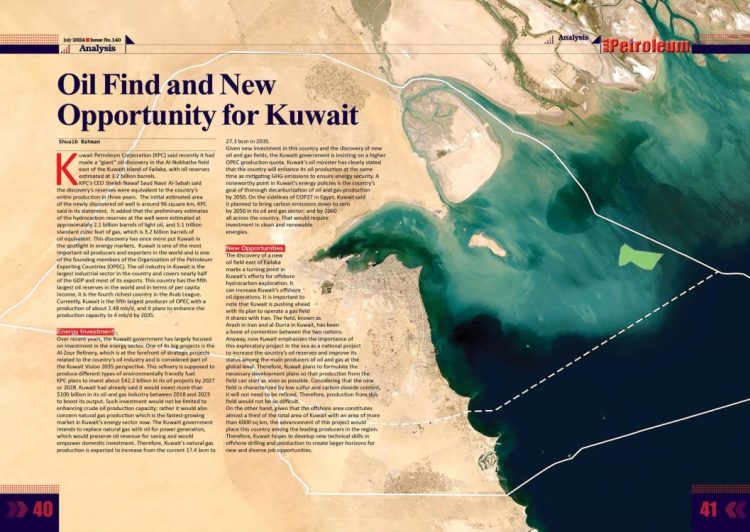Kuwait Petroleum Corporation (KPC) said recently it had made a “giant” oil discovery in the Al-Nokhatha field east of the Kuwaiti island of Failaka, with oil reserves estimated at 3.2 billion barrels.
KPC’s CEO Sheikh Nawaf Saud Nasir Al-Sabah said the discovery’s reserves were equivalent to the country’s entire production in three years. The initial estimated area of the newly discovered oil well is around 96 square km, KPC said in its statement. It added that the preliminary estimates of the hydrocarbon reserves at the well were estimated at approximately 2.1 billion barrels of light oil, and 5.1 trillion standard cubic feet of gas, which is 3.2 billion barrels of oil equivalent. This discovery has once more put Kuwait in the spotlight in energy markets. Kuwait is one of the most important oil producers and exporters in the world and is one of the founding members of the Organization of the Petroleum Exporting Countries (OPEC). The oil industry in Kuwait is the largest industrial sector in the country and covers nearly half of the GDP and most of its exports. This country has the fifth largest oil reserves in the world and in terms of per capita income, it is the fourth richest country in the Arab League. Currently, Kuwait is the fifth largest producer of OPEC with a production of about 2.48 mb/d, and it plans to enhance the production capacity to 4 mb/d by 2035.
Energy Investment
Over recent years, the Kuwaiti government has largely focused on investment in the energy sector. One of its big projects is the Al-Zour Refinery, which is at the forefront of strategic projects related to the country’s oil industry and is considered part of the Kuwait Vision 2035 perspective. This refinery is supposed to produce different types of environmentally friendly fuel.
KPC plans to invest about $42.2 billion in its oil projects by 2027 or 2028. Kuwait had already said it would invest more than $100 billion in its oil and gas industry between 2018 and 2023 to boost its output. Such investment would not be limited to enhancing crude oil production capacity; rather it would also concern natural gas production which is the fastest-growing market in Kuwait’s energy sector now. The Kuwaiti government intends to replace natural gas with oil for power generation, which would preserve oil revenue for saving and would empower domestic investment. Therefore, Kuwait’s natural gas production is expected to increase from the current 17.4 bcm to 27.3 bcm in 2035.
Given new investment in this country and the discovery of new oil and gas fields, the Kuwaiti government is insisting on a higher OPEC production quota. Kuwait’s oil minister has clearly stated that the country will enhance its oil production at the same time as mitigating GHG emissions to ensure energy security. A noteworthy point in Kuwait’s energy policies is the country’s goal of thorough decarburization of oil and gas production by 2050. On the sidelines of COP27 in Egypt, Kuwait said it planned to bring carbon emissions down to zero by 2050 in its oil and gas sector; and by 2060 all across the country. That would require investment in clean and renewable energies.
New Opportunities
The discovery of a new oil field east of Failaka marks a turning point in Kuwait’s efforts for offshore hydrocarbon exploration. It can increase Kuwait’s offshore oil operations. It is important to note that Kuwait is pushing ahead with its plan to operate a gas field it shares with Iran. The field, known as Arash in Iran and al-Durra in Kuwait, has been a bone of contention between the two nations. Anyway, now Kuwait emphasizes the importance of this exploratory project in the sea as a national project to increase the country’s oil reserves and improve its status among the main producers of oil and gas at the global level. Therefore, Kuwait plans to formulate the necessary development plans so that production from the field can start as soon as possible. Considering that the new field is characterized by low sulfur and carbon dioxide content, it will not need to be refined. Therefore, production from this field would not be so difficult.
On the other hand, given that the offshore area constitutes almost a third of the total area of Kuwait with an area of more than 6000 sq km, the advancement of this project would place this country among the leading producers in the region. Therefore, Kuwait hopes to develop new technical skills in offshore drilling and production to create larger horizons for new and diverse job opportunities.








